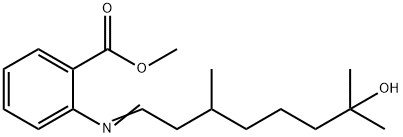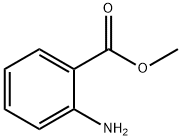AURANTIOL
Synonym(s):7-Hydroxy-3,7-dimethyl-octanal
- CAS NO.:89-43-0
- Empirical Formula: C18H27NO3
- Molecular Weight: 305.41
- MDL number: MFCD00021817
- EINECS: 201-908-1
- SAFETY DATA SHEET (SDS)
- Update Date: 2024-12-18 14:15:30

What is AURANTIOL?
Chemical properties
Viscous, colorless, or faintly yellow liquid; sweet lily-type odor.Soluble in alcohol (50%), fixed oils; slightly soluble in water, glycerol, and mineral oil. Combustible.
Occurrence
Has apparently not been reported to occur in nature.
The Uses of AURANTIOL
Perfumery (fixative, muguet odor), flavoring, soap and cosmetic fragrances.
The Uses of AURANTIOL
hydroxycitronellal is used to mask odor.
Preparation
By hydration of citronellal (Bedoukian, 1967).
What are the applications of Application
This Schiff-s base Aurantiol is the most widely used of all Schiff's bases known in perfumery. Its low cost and considerable strength, its tenacity and versatility are virtues that make the product applicable in fragrances of all price levels and for numerous purposes. Obviously and almost inevitably used in Orange blossom, Neroli and related heavy florals, it finds use in smaller amounts in countless other fragrant types: Citrus blends, Ambres, and Orientals. Chyprcs, etc. It forms the steady undertone in many such sweet florals, in Honeysuckle, Frangipanni, Magnolia, exotic florals, etc. In the Citrus Cologne types, it has the ability to appear even in the initial notes, besides being a fixative. Used for nearly 50 years, it has been brought "back to life" several times, e. g., when the fruity-musky perfume was fashionable (and still is, to a certain degree), that perfume had a solid undertone of this type of material, backed up by Ethylene brassylate and Undecanolide in unusually high proportions. This base has a perceptible effect in a perfume oil at concentrations beginning well below 1%, but is often used at a much higher level.
Synthesis Reference(s)
The Journal of Organic Chemistry, 39, p. 108, 1974 DOI: 10.1021/jo00915a028
Trade name
Aurantiol Pure (Givaudan).
Properties of AURANTIOL
| Boiling point: | 445.7±45.0 °C(Predicted) |
| Density | 1.01±0.1 g/cm3(Predicted) |
| Flash point: | 97℃ |
| solubility | Almost insoluble in water, soluble in alcohol and oils, poorly soluble in Propylene glycol. |
| form | Intensely yellow, viscous to very viscous liquid |
| pka | 15.31±0.29(Predicted) |
| Odor | at 50.00 % in dipropylene glycol. floral lily orange blossom sweet |
| EPA Substance Registry System | Benzoic acid, 2-[(7-hydroxy-3,7-dimethyloctylidene)amino]-, methyl ester (89-43-0) |
Safety information for AURANTIOL
Computed Descriptors for AURANTIOL
AURANTIOL manufacturer
New Products
(S)-3-Aminobutanenitrile hydrochloride 4-Methylphenylacetic acid N-Boc-D-alaninol N-BOC-D/L-ALANINOL Tert-butyl bis(2-chloroethyl)carbamate 3-Morpholino-1-(4-nitrophenyl)-5,6-dihydropyridin- 2(1H)-one Furan-2,5-Dicarboxylic Acid Tropic acid 1-Bromo-3,5-Di-Tert-Butylbenzene S-2-CHLORO PROPIONIC ACID ETHYL ISOCYANOACETATE 2-Bromo-1,3-Bis(Dimethylamino)Trimethinium Hexafluorophosphate 4-IODO BENZOIC ACID 3-NITRO-2-METHYL ANILINE 1-(2,4-DICHLOROPHENYL) ETHANAMINE (2-Hydroxyphenyl)acetonitrile 4-Bromopyrazole 2-(Cyanocyclohexyl)acetic acid 4-methoxy-3,5-dinitropyridine 1-(4-(aminomethyl)benzyl)urea hydrochloride 2-aminopropyl benzoate hydrochloride diethyl 2-(2-((tertbutoxycarbonyl)amino) ethyl)malonate tert-butyl 4- (ureidomethyl)benzylcarbamate Ethyl-2-chloro((4-methoxyphenyl)hydrazono)acetateRelated products of tetrahydrofuran




You may like
-
 89-43-0 Aurantiol 98%View Details
89-43-0 Aurantiol 98%View Details
89-43-0 -
 89-43-0 98%View Details
89-43-0 98%View Details
89-43-0 -
 METHYL N-(3,7-DIMETHYL-7-HYDROXYOCTYLIDENE)-ANTHRANILATE CAS 89-43-0View Details
METHYL N-(3,7-DIMETHYL-7-HYDROXYOCTYLIDENE)-ANTHRANILATE CAS 89-43-0View Details
89-43-0 -
 1975-50-4 98%View Details
1975-50-4 98%View Details
1975-50-4 -
 2-HYDROXY BENZYL ALCOHOL 98%View Details
2-HYDROXY BENZYL ALCOHOL 98%View Details
90-01-7 -
 2-Chloro-1,3-Bis(Dimethylamino)Trimethinium Hexafluorophosphate 221615-75-4 98%View Details
2-Chloro-1,3-Bis(Dimethylamino)Trimethinium Hexafluorophosphate 221615-75-4 98%View Details
221615-75-4 -
 14714-50-2 (2-Hydroxyphenyl)acetonitrile 98+View Details
14714-50-2 (2-Hydroxyphenyl)acetonitrile 98+View Details
14714-50-2 -
 118753-70-1 98+View Details
118753-70-1 98+View Details
118753-70-1